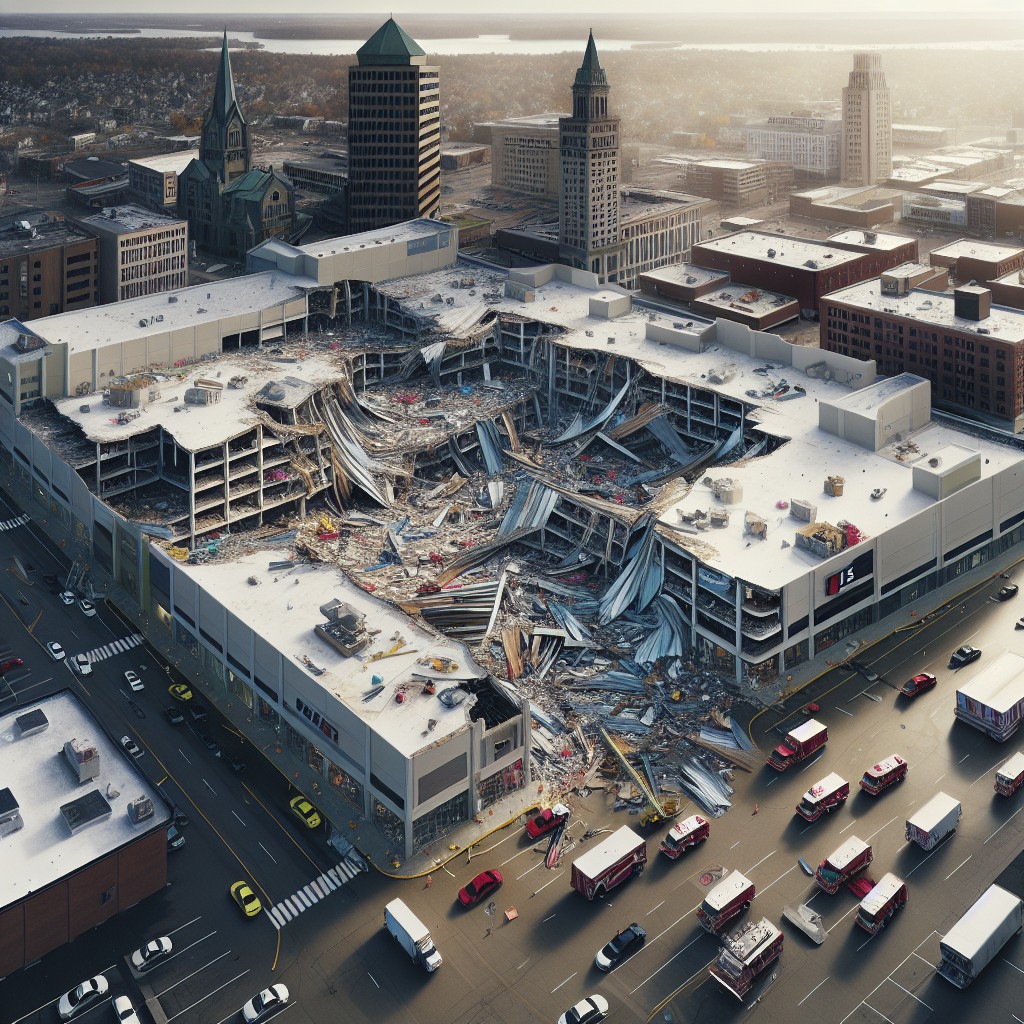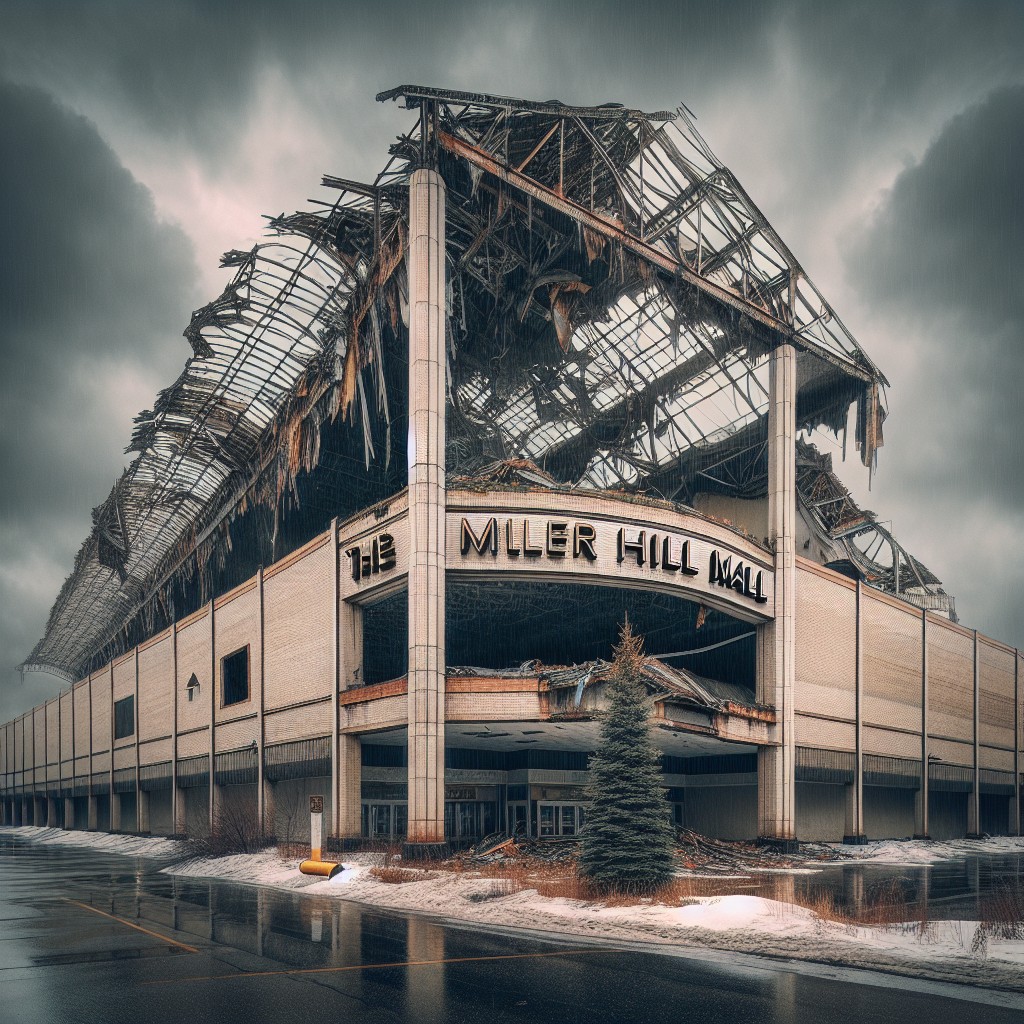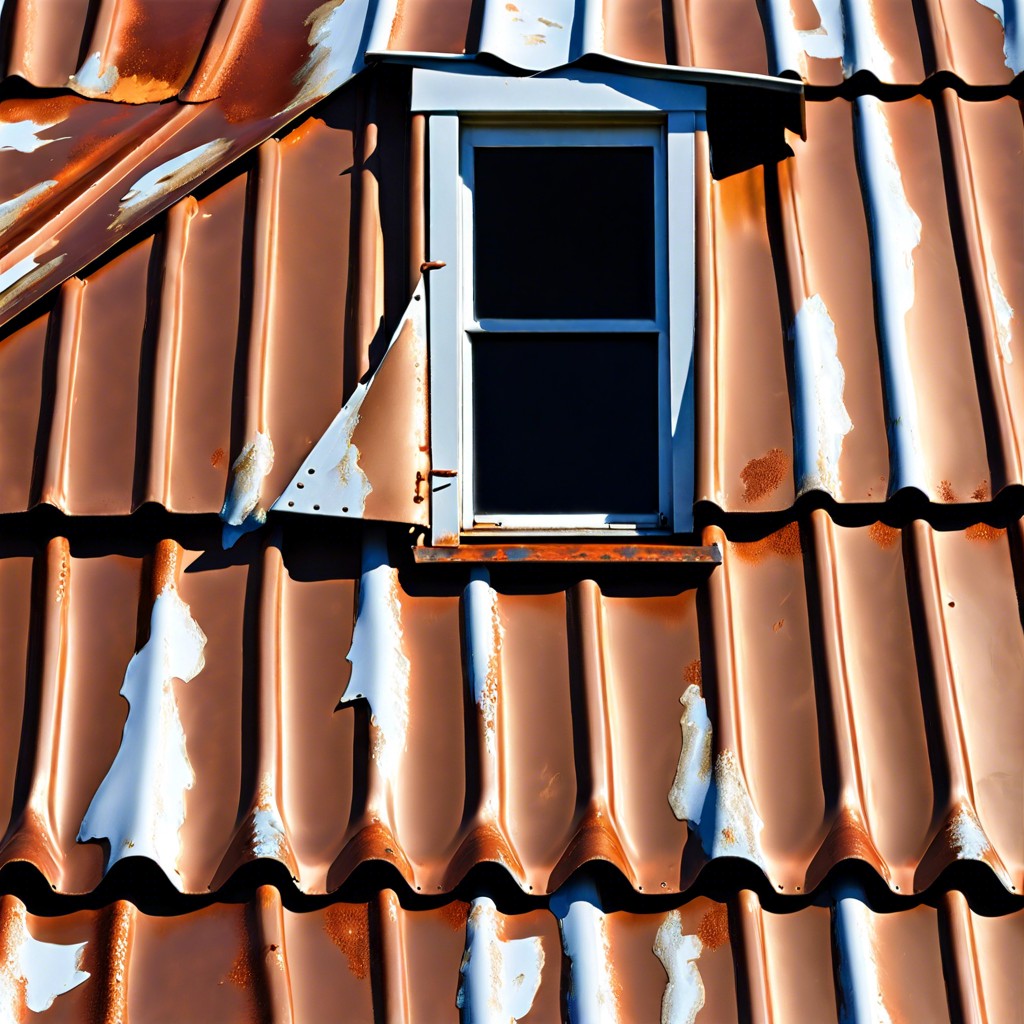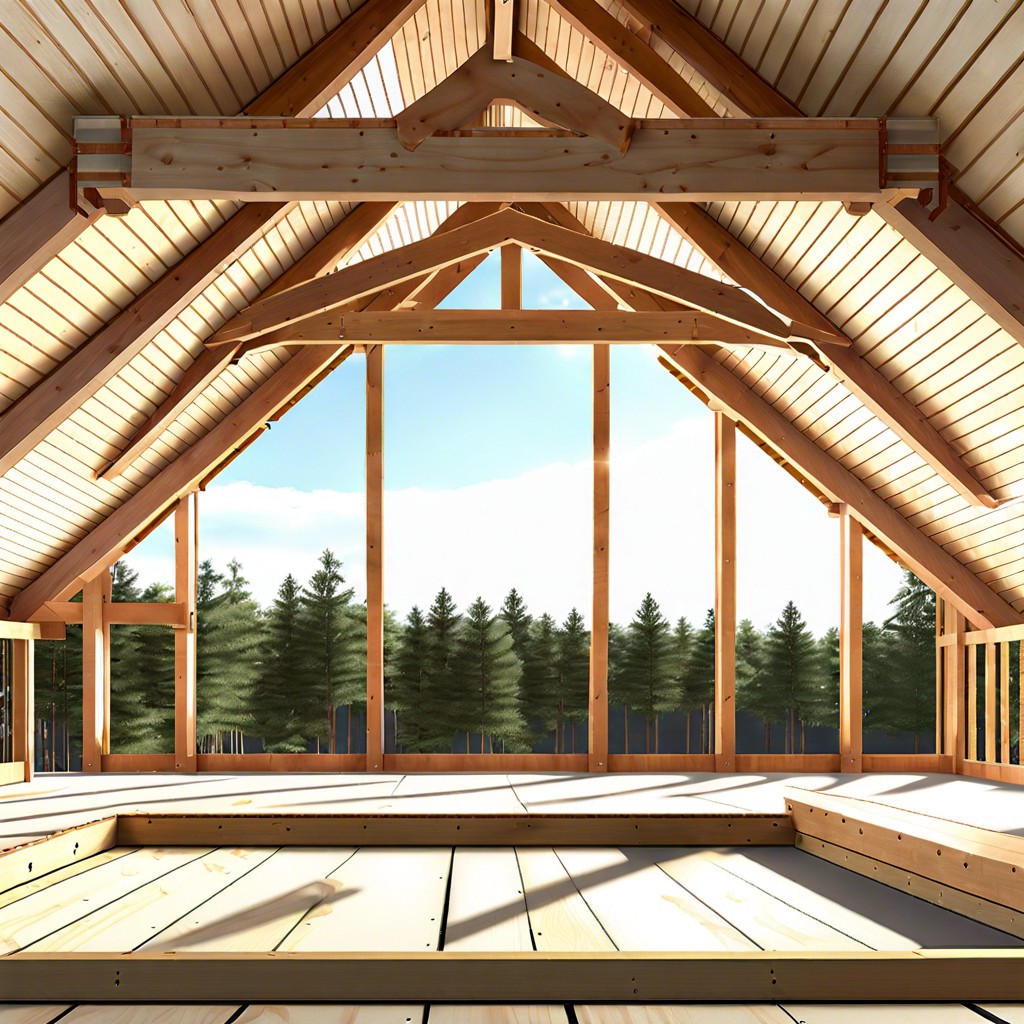Last updated on
Explore the intricacies of the Duluth MN Miller Hill Mall roof collapse because understanding its causes and aftermath reveals crucial insights for improving structural resilience.
In the brisk pre-dawn hours at Duluth’s Miller Hill Mall, the roof’s integrity succumbed to the weight of relentless snowfall, a dramatic collapse that echoed through the empty corridors. Fortuitously, the incident occurred outside the mall’s regular hours, averting a crisis that could have involved many.
The few on-site individuals, quick to register the calamity, enabled a prompt and efficient evacuation. This event offers a stark reminder of nature’s impact on architectural durability and the importance of structural assessments, particularly in regions prone to heavy snow.
Read on as we delve into the specifics of the collapse, examining the contributing factors and timely response that mitigated a potentially disastrous situation.
Key takeaways:
- Incident took place in April, outside of operational hours, reducing risk of casualties.
- Sounds of the collapse alerted the few present, leading to a swift reaction.
- The timing facilitated a more manageable evacuation and response effort.
- Early morning incident allowed for immediate assessment without daylight constraints.
- Excessive snowfall was the primary cause of the collapse.
Background of Miller Hill Mall Roof Collapse

Situated in the heart of Duluth, Minnesota, Miller Hill Mall serves as a bustling hub for shopping and social gatherings. On the fateful day of the roof collapse, regular business activities filled the mall, with shoppers and employees going about their day.
The affected area, a portion of the mall’s expansive roofing, had been engineered to withstand typical regional weather conditions. However, unforeseen factors led to the structural failure. In the aftermath, mall management joined hands with local authorities, promptly addressing the situation to ensure public safety and minimize disruptions.
The incident prompted a closer examination of building codes and maintenance practices, as well as a review of emergency response protocols, underscoring the importance of proactive infrastructure assessment in the face of changing environmental patterns.
Date and Time of the Incident

The roof collapse at the Miller Hill Mall occurred during the early hours of an April morning, well before the usual business opening hours. This timing was crucial in avoiding potential injuries as the mall was largely empty.
Retail staff and early morning mall walkers reported hearing the unmistakable sounds of the failing structure, triggering the immediate closure of the affected area.
Key Points:
- Incident took place in April, outside of operational hours, reducing risk of casualties.
- Sounds of the collapse alerted the few present, leading to a swift reaction.
- The timing facilitated a more manageable evacuation and response effort.
- Early morning incident allowed for immediate assessment without daylight constraints.
Specific Location of the Collapse Within the Mall
The collapse occurred in a section of the mall located near the Barnes & Noble and Old Navy stores. This particular area, a nexus for foot traffic, is characterized by an expansive flat roof, a common architectural feature for commercial buildings designed to maximize interior space.
Flat roofs are particularly susceptible to the accumulation of snow and water, often leading to increased stress on the structure. Understanding the role this roof design plays in weight distribution can shed light on potential vulnerabilities, especially in regions subjected to heavy snowfall such as Duluth, Minnesota.
Following the incident, the integrity of surrounding zones was quickly assessed to ensure shopper safety and the structural stability of adjacent retail spaces.
Reported Cause of the Roof Collapse
An investigation into the collapse revealed that the weight of snow and ice accumulation on the roof was the primary factor. This weight exceeded the designed load-bearing capacity, leading to structural failure. This phenomenon, known as roof overload, is not uncommon in regions with heavy snowfall, like Duluth.
Key points to understand:
- Roofs have specific load-bearing capacities based on their design and construction materials.
- Excessive snowfall can result in a buildup of weight that surpasses these limits.
- Regular maintenance and snow removal are critical in preventing such occurrences.
- The varying density of snow can also impact the overall weight – wet, heavy snow poses a greater risk.
- In this case, the combination of long-term accumulation and possibly inadequate snow removal could have contributed to the structural failure.
Immediate Response and Evacuation Procedures
Upon detecting signs of structural failure, mall personnel promptly initiated emergency protocols. A swift evacuation was carried out to ensure the safety of both shoppers and staff.
Key Points:
- 1. Store associates directed customers to the nearest exits in a calm and orderly manner.
- 2. Emergency services were immediately alerted to the situation, resulting in quick dispatch of police, firefighters, and emergency medical teams.
- 3. Mall security helped to manage the crowd and prevent panic, guiding individuals away from the affected area.
- 4. Access points to the affected zone were cordoned off to avoid potential injuries from any further collapses or debris.
- 5. The established emergency response plan was successfully implemented, showcasing the importance of regular drills and preparedness.
The focus on rapid response and organized evacuation minimized the risk of injury and facilitated the arrival of first responders.
Assessment of Structural Damage
Following the collapse, structural engineers swiftly evaluated the site to determine the extent of damage. Key points of this assessment included:
- Integrity of Supporting Structures: The team examined the remaining sections of the roof and supporting beams to identify any compromise in structural integrity.
- Load-Bearing Capacities: Analysis of the load-bearing walls and columns was crucial to ensure they hadn’t been weakened, potentially affecting the mall’s stability.
- Potential for Further Damage: Experts looked for signs of stress in adjacent areas that might suggest a risk of additional collapses.
- Water Infiltration: The incident might have caused breaches, leading to water damage that can weaken the mall’s structure further; thus, moisture assessment was vital.
- Electrical Systems: Safety checks on the electrical wiring and fixtures in the affected area were performed to prevent fire hazards or short circuits.
- Preliminary Estimate for Repairs: A rough cost and timeline were proposed to address the damage, enabling planning for necessary reconstruction.
This comprehensive assessment is foundational to mapping out a safe and efficient repair process, essential for a timely return to normal operations.
Impact On Mall Operations and Visitors
The sudden collapse significantly disrupted daily activities, with several sections of the mall closing for safety assessments. As a central hub for shopping and social gatherings, the impact rippled through the local community.
Retailers faced temporary closures, hampering sales and causing potential financial strain. For visitors who frequent the mall for leisure and essential shopping, the incident resulted in the redirection to alternative venues, adjusting routines and shopping habits.
Additional security measures and safety precautions were promptly implemented to ensure the well-being of patrons and staff during the preliminary investigations and throughout the repair process. The event highlighted the importance of structural integrity and ongoing maintenance in public spaces.
Safety Inspections and Regulatory Response
Following the collapse, safety inspectors from the city and structural engineers were promptly dispatched to evaluate the integrity of the remaining roof structure and the building as a whole. These inspections are crucial to ensure that no further risk is posed to emergency responders, mall employees, or the public.
Key points of focus during the inspections included:
- Identifying the specific failure points and contributing factors.
- Checking for additional structural weaknesses throughout the mall.
- Recommending immediate safety measures to prevent secondary incidents.
- Ensuring compliance with current building codes and regulations.
The regulatory response typically involves a detailed review of maintenance records to confirm adherence to required safety standards and protocols. If lapses or violations are found, the mall management may face penalties or be required to make necessary improvements. These actions serve not only to address the current situation but also to mitigate the potential for future occurrences.
Efficient collaboration with local authorities ensures that all findings from the inspections are transparently communicated and that a coordinated effort is made to restore safety, confirm structural integrity, and guide the subsequent repair process.
Repair and Reconstruction Efforts
Following the collapse, a comprehensive analysis was promptly initiated to determine the extent of the damage. This critical step ensured that repair efforts would address structural weaknesses, not just superficial damages.
Skilled construction teams were deployed, focusing on restoring the roof’s integrity and ensuring compliance with current building codes.
Emphasizing safety, the reconstruction plan encompassed both short-term fixes to expedite reopening sections of the mall and long-term solutions to prevent future incidents.
Advanced materials designed to withstand heavy snow loads and extreme weather conditions were selected, reflecting Duluth’s climate.
Throughout the process, mall management maintained a transparent line of communication with tenants and the public, providing updates on progress and anticipated completion dates.
Additionally, intensive inspections by structural engineers became part of the routine to reaffirm the ongoing safety of the site.
Efficiency was balanced with thoroughness, as the aim was not only to reopen rapidly but to do so without compromising safety or quality.
Collaboration between construction teams, engineers, and local authorities helped streamline the reconstruction efforts, with the goal of welcoming visitors back to a safer, sturdier shopping environment.
Financial Implications for the Mall and Affected Businesses
The financial impact of such an event extends beyond immediate repair costs. Mall revenues take a hit due to temporary closure, affecting not only the mall owner but also tenants. Small businesses and local retailers, in particular, may struggle with the loss of sales and disruption in their operations.
Insurance claims can provide some relief, but policy coverage limits and deductibles could leave significant out-of-pocket expenses. Additionally, liability concerns arise if the collapse resulted from neglected maintenance or structural faults, potentially leading to costly legal proceedings.
The downtime also triggers a ripple effect on employment, with staff facing reduced hours or layoffs during the restoration period. This economic stress extends to the wider community, given that malls often serve as hubs of commerce and social interaction within a city.
Overall, a thorough evaluation of the short and long-term financial repercussions is crucial for swift recovery and to bolster resilience against future incidents.
Reopening Status of Businesses Within the Mall
Following structural assessment and necessary repairs, businesses within Miller Hill Mall have gradually resumed operations. The reopening timeline has varied, with some shops ready to welcome customers shortly after ensuring their spaces are safe, while others have taken additional time to repair internal damage.
The mall management has worked closely with business owners to facilitate swift and coordinated reopening plans. It’s important to note that the well-being of shoppers and staff remains a top priority, with all areas thoroughly inspected before public entry is permitted.
Patrons can check the mall’s website or contact individual stores for the most up-to-date information on specific reopening dates and hours of operation.
Continued Safety Measures and Monitoring
Following the structural failure at Miller Hill Mall, stringent safety protocols have been implemented to prevent future incidents. Regular inspections are now a priority, tightly scheduled to monitor the integrity of the roofing system and ensure compliance with building codes.
Advances in sensor technology allow for real-time monitoring, providing continuous data on the roof’s condition and alerting management to potential hazards. Additionally, emergency preparedness drills have become more frequent, equipping staff and shoppers with clear guidelines on how to respond swiftly in crisis scenarios.
These measures not only fortify the mall’s infrastructure but also aim to restore confidence among its patrons.
Latest News Update Related to the Roof Collapse
In the latest updates on the Miller Hill Mall roof collapse in Duluth, MN:
- Authorities have confirmed that the mall is structurally safe for shoppers, with only the affected section remaining cordoned off.
- Engineers have cited excessive snowfall as the primary stressor leading to the collapse.
- Remediation work has begun, including snow removal and reinforcing other potentially vulnerable roof sections.
- Four stores nearest to the collapse site remain closed, with plans to reopen after repairs ensure the safety of patrons and staff.
- Officials announced a scheduled reopening of the entire mall, with dates subject to change depending on weather conditions and pace of repair work.
- The Duluth community receives regular updates through official channels to stay informed on progress and any changes in the mall’s operational status.
FAQ
Did the roof collapse on the Miller Hill Mall in Duluth Minnesota?
Yes, the roof of the Miller Hill Mall in Duluth, Minnesota did collapse.
Which mall roof collapsed in Minnesota?
The roof that collapsed was at the Miller Hill Mall in Duluth, Minnesota.
When did the Elliot Lake mall collapse?
The Elliot Lake mall collapse occurred on June 23, 2012.
What were the causes and contributing factors to the Duluth MN Miller Hill Mall roof collapse?
The Duluth MN Miller Hill Mall roof collapse was primarily caused by the excessive accumulation of snow and ice, coupled with structural weaknesses in the building’s design.
What safety measures were implemented in Minnesota malls post the roof collapse incident?
Following the roof collapse incident in Minnesota malls, the implemented safety measures included routine structural assessments, the installation of additional structural reinforcements, and the enforcement of stricter building codes and standards.
How was the recovery and rebuilding process managed after the Elliot Lake mall collapse?
The recovery and rebuilding process after the Elliot Lake mall collapse was managed by multiple investigatory bodies along with local construction contractors who worked diligently to secure the area, analyze the cause of the catastrophe, and redevelop the space into a community hub.




